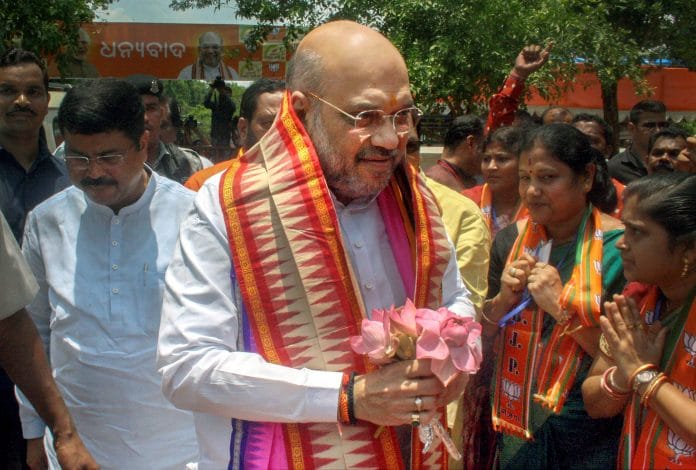Share of upper caste vote within the BJP’s Hindu social coalition has continuously declined over the past two decades.
In a fascinating study of the Bharatiya Janata Party’s (BJP) organisational structure, a team of journalists at ThePrint found that upper caste politicians occupy nearly two-thirds of the positions within the national executive, and as state and district unit presidents. Should this worry the BJP leadership? Scholars of political parties argue that organisations in their expansion mode often develop contradictory tendencies or internal pressures, which if not dealt adequately and in time may become a reason for its degeneration.
The BJP, it seems, is undergoing a similar phase. While the social base of the party now consists of more voters from the lower rungs of Hindu society, its leadership positions largely remain the preserve of few. Scholars distinguish between three different faces of a party: the party in public office, the party in central office and the party on the ground. The public office element deals with government and legislative aspects, central office deals with party platforms and leadership, and the ground element deals with party activists and the electorate.
These three elements, although largely overlap with each other, serve different purposes. This organisational perspective also helps in understanding the internal and external environment in which a party operates.
Traditionally, the BJP’s support base has been mainly among the Hindu upper castes. In the late 1980s, the emergence of new political formations, articulating the interests of the Other Backward Class (OBCs) and Dalits, forced the BJP to realise that if it intended to expand electorally, it too must become responsive to the leadership ambitions of these groups. K.N. Govindacharya, the Rashtriya Swayamsevak Sangh (RSS) ideologue, theorised the effort of promoting backward caste leaders as ‘social engineering’. This new political strategy helped the BJP make electoral gains in several parts of the country, and the party became a principal player in many states of northwest India. But the backward caste upsurge in the BJP turned out to be a short-lived affair due to the attempts at tightening the upper caste grip over the party under the leadership of Atal Bihari Vajpayee.
The 2014 election not only consolidated the BJP’s traditional support among the upper castes, but also managed to attract a large number of voters from the OBCs, Dalits and Adivasis. This electoral upswing marked the highpoint of slow transformation that was taking place within the BJP’s vote base. As evident from Figure 1, the share of upper caste vote within the BJP’s Hindu social coalition has continuously declined over the past two decades. It also becomes evident that the BJP is undergoing a process of mandalisation. The OBC vote constituted the largest component within the total vote secured by the party. In fact, the share of OBC votes has surpassed the vote from the upper castes. The share of Scheduled Caste (SC) and Scheduled Tribe (ST) votes within the BJP’s social coalition too has increased.

To put it simply, of every 100 votes that the BJP now receives among Hindus, 44 belong to the OBCs, 31 to the upper castes and 25 to the SCs and the STs. This ratio was very different two decades ago, when of every 100 votes among Hindus, 45 came from the upper castes, 35 from the OBCs and only 20 from the SCs and the STs.
Also read: Why ThePrint is wrong about the BJP being an upper-caste party
While the profile of the typical BJP voter has changed dramatically between 2009 and 2014, the caste profile of BJP parliamentarians has largely remained the same (see Table 1). Two-thirds of the cabinet ministers belong to the upper castes, which is highly asymmetrical to the extent of support the party receives from this social section. Moreover, almost half of the non-upper caste cabinet ministers belong to the BJP allies, and not the BJP. The scenario is not very different if one looks at the caste background of chief ministers in the BJP/NDA-governed states.

The biggest challenge before the BJP, therefore, is the mismatch between the altered electoral support base of the party consisting primarily of the OBCs, Dalits and Adivasis on the one hand, and the largely unchanging social character of its leadership on the other. The party would do well to recall that the Congress party’s failure to accommodate the aspiring leadership among various non-upper caste communities in 1960s led to its gradual decline. The representational blockage impelled the leaders from the emergent intermediate and lower castes to leave the Congress. They had to either form new parties, mostly regional in character, or join other parties in search of power and position.
If the BJP continues to remain the preserve of the upper castes and does not align with the democratisation of its support base, it is bound to become a major source of tension within the party in the coming years.
The writer is a Ph.D. student in political science at the University of California at Berkeley, US. His twitter handle is @rahul_tverma







True facts.The participants of the political process would always be the poor & backward in any country.
I dont agree with the concluding paragraph though,every party would have a future even if they have a high class leadership…the evidence is all around us.
Rahul Gandhi is a great asset for BJP
The fact is that in all national parties including the communist party, the upper castes have more representation at the leadership level than their number in BJP. Secondly the data is not fully correct due to the very large number of unknowns. Leaving that aside, the number of higher castes is nearly equal to the number of non-higher-castes. This is quite an achievement, which has not been achieved by any national party.